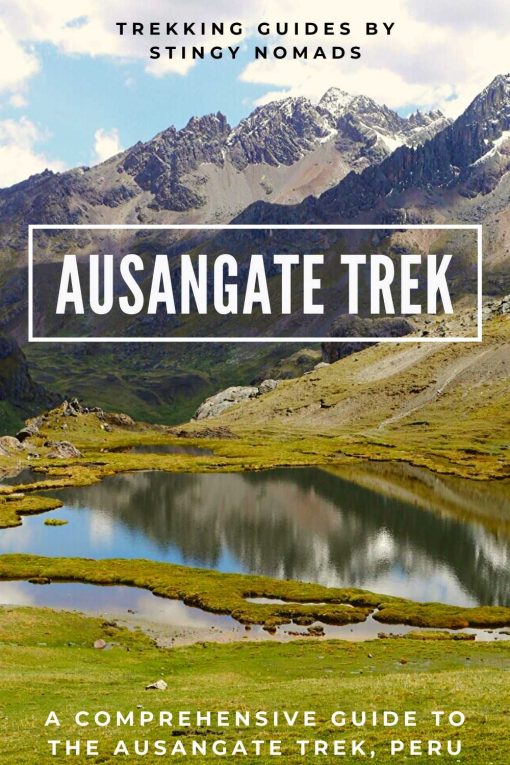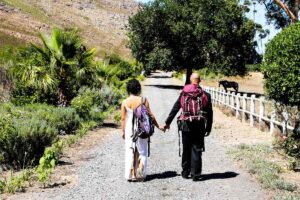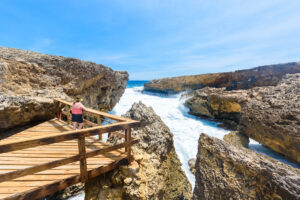[ad_1]
The Ausangate trek is a high altitude 70km hike in the Peruvian mountains near Cusco with an average altitude of over 4000m. Unlike most other hikes in the region Ausangate is not about Inca ruins, it’s all about beautiful scenery; snow peaks, glaciers, colorful mountain lakes, and the Rainbow mountain. If you like beautiful nature, going off the beaten track and hiking this trek is for you.
Ausangate is one of the most challenging hikes around Cusco but at the same time one of the most rewarding in sense of scenery. If you have any doubts about hiking Ausangate on your own read this article we hope it’ll help you decide whether to do an independent or guided trek. For more info on all our favorite hikes in Peru.
Ausangate trek overview
- Total distance – 70km/43 miles
- Required number of days – 4 to 5 days
- Starting/finishing point – Tinqui (Tinki)
- Average altitude – over 4000m/13 123ft
- Highest points – Arapa Pass – 4850m/16 000ft; Palomani Pass – 5165m/17 000ft
Information on other hikes around Cusco you can find on our Choquequirao trek guide and Salkantay to Machu Picchu guide.
If you’re thinking about exploring more of Peru there are several great small group tour options to join;
Best time for trekking
There are two main seasons in Cusco; dry season and rainy season. Dry season; May to September – almost no rain, quite cold especially at night in the mountains. April and October – chances of rain are higher though it’s warmer. Due to high altitude in winter months, from June to August, some parts of the trek might be covered in snow. Rainy season; November to March – it’s warmer and rains a lot. The period from December to February is the worst time for hiking in the region.
Need to know about the trek
It’s a high altitude trek good acclimatization is essential. Maybe do another hike with lower altitudes to acclimatize and to see your body reaction.
Drink enough water it’s important when hiking at high altitudes.
There are many creeks and rivers on the route but we recommend to bring a Lifestraw bottle or water purifying tablets due to the huge number of alpacas walking all over the mountains you can’t know how clean is the water. Nothing can be worse than getting sick at high altitude or have a running stomach.
There are no lodges or established campsites with facilities you must be self-sufficient.
A good map or GPS navigation is highly recommended for this trek.
There is very limited/no cell phone reception.
Your camping gear must be reliable and suitable for low temperatures, at night it can go down below 0°C.
Expect to see many people at Rainbow Mountain if you want to keep the trek more authentic you can skip it and rather visit as a day trip from Cusco. The Mountains adds one extra day to the itinerary, plus there will be many tourists, locals with decorated alpacas etc. all the normal stuff you see on the streets of Cusco or around Machu Picchu.

How we rank the Ausangate trek
- Difficulty level – 5 out of 5; remote, high altitude, several steep ascents, and descents.
- Scenery – 5 out of 5; we absolutely loved this trek, the scenery is amazing, one of the most beautiful hikes we’ve done; colorful lakes, snow peaks, rainbow mountains, waterfalls etc.
- Touristy – 2 out of 5; it’s one of the less touristy hikes around Cusco, the only part where you might see many tourists is Rainbow Mountain.
Altitude sickness
Many people arriving in Cusco by bus from Lima or the Amazon get altitude sickness. It is normal if you fly or go by bus from a low altitude to a location more than 3000m above it. Our body needs time to adjust to the decreasing amount of oxygen available due to the altitude, the higher you go the lower the air pressure and the less oxygen available to you.
Symptoms
There are three types of altitude sickness; Mild Altitude Sickness, HAPE and HACE – the last two are lethal. The Mild Sickness is the first stage that if you don’t take precautions, it can develop into one of the lethal types. Having Mild Altitude Sickness is similar to having a hangover; headache, nausea, fatigue. Many people feel it for the first couple of days in Cusco.
How to prevent
- First days in Cusco rest and sleep, don’t walk too much and definitely don’t exercise.
- Drink enough water. Locals in Peru and Bolivia drink a lot of “coca tea” a hot drink made with leaves – it’s considered to help acclimatization.
- Don’t consume alcohol.
- Don’t go any higher if you skip acclimatization at lower altitudes you won’t acclimatize if you go higher.
- Try to sleep at lower altitudes – “climb high, sleep low”.
- You can take Diamox, this medication speeds up acclimatization, consult your doctor before taking it.
Travel insurance for the trek
Hiking like any outdoor activity involves risks of getting injured, losing or breaking gear, cancellation of the trip due to bad weather, etc. The Ausangate trek is a high altitude route through remote areas of the Andes it’s highly recommended to have travel insurance that covers you for the period of the hike.
Choosing an insurance company that you can rely on in case of emergency is very important, we recommend World Nomads. The company focuses on covering outdoor activities including trekking. Peru is one of their top hiking destinations it means they have experience in working with local companies. A great thing about World Nomads is that you can buy insurance online while traveling, it takes only a couple of minutes. Their insurance policy is very flexible you can buy insurance to cover the whole period of the trip or only the hiking part of it, even if it’s one or two days. Get a quote right now!
Note! Always read carefully terms and conditions.
Ausangate trek packing list
As I already mentioned above your gear must be reliable and suitable for low temperatures, rain and windproof.
Tent – a good tent that won’t leak if it rains or breaks in the strong wind plus light and easy to pitch. We used to spend as little money on possible on our gear but we learned from our own experience that it doesn’t help to buy cheap stuff that will break quickly or will give you a lot of trouble every time you use it. Our last camping gear upgrade was an MSR tent that we wanted to buy for a long time and finally got it, now we can’t wait to go hiking again. It’s light, easy to pitch, water and wind resistible.
Sleeping bag – we prefer synthetic bags just because they dry quick and last long, down bags are awesome; warm, comfortable and very light but they become a problem if they get wet and after a year or so of active using they start losing feathers. A good sleeping bag can go to or below 0°C .
Sleeping mat – in the beginning, we used to carry foam mats but after a month of carrying it attached to your backpack they look terrible we decided to switch to inflatable mattresses that can be packed away in the backpack. We love our mats; they are small, light, quick to inflate, soft and durable.
You can find more information on packing for the trek in our Detailed packing list for hiking and camping in Peru.
Download our complete Ausangate trek packing list.
Guided tour or independent hike
Ausangate is considered to be the toughest and one of the most remote hikes in the region if you’re a hiking newbie we’d strongly recommend to do the trek with a company and let them arrange everything and guide you through the route. If you’re an experienced hiker, have done high altitude hikes before and proper acclimatized – go on your own. Here are our pros and cons for an independent and guided hike.
Independent hike
Pros
- You’re very flexible with distances and times; start and finish when you want, stop where you like etc.
- It’s a real adventure that you plan on your own.
Cons
- You have to carry all your gear and food.
- You can rely only on yourself there is no backup.
- It’s not always fun to pitch a tent and make food after a long and tough walking day.
Guided hike
Hiking Ausangate on your own is a true adventure, we saw nobody else for a whole week, being at high altitude the trek is quite tough and since the route is not always very well marked navigation can be challenging.
Many hikers are more comfortable to leave planning and logistics to an experienced company that knows the area. Runnatrip is a group of professional trekkers that can guide you to experience the beauty of this amazing trek! Check them out for an organized Ausangate Trek, all you have to do is reserve your spot!
If you don’t have time to complete the route you can do a day tour from Cusco to Rainbow Mountain and hike to the top of it from where you can see Ausangate mountain.
Pros
- It’s less stressful, no planning or preparing involved, just find a good reliable company and they will arrange everything for you.
- The walk is easier you carry only your day-pack the rest is transferred by horses.
- If you travel alone it’s more fun to hike in a group than wander on your own in the mountains (not for everybody).
- Part of the money you spend goes to the local community; guides, cook, muleteer (though the small part).
Cons
- It’s more expensive, a lot more actually.
- You might be unlucky with a group or a guide and it will spoil your hike.

Ausangate trek cost
Without a guide, per person
If you do it independently it’s very cheap especially if you have your own camping gear; no paid accommodation, no big entrance fees, the only expenses; transport to get there and back (public bus) and food for the hike.
Transport (bus Cusco – Tinqui – Cusco) – 20 Sol/US$6 return.
Shopping (food, gas) – 100 Sol/US$30.
Entrance fee – 10 Sol/US$3 at the exit from Tinqui there is a small kiosk where you pay the park entry fee, not sure what park but looked more or less official.
Gear rental (optional) – depending on what you’re going to rent it will cost you between 160 Sol/US$50 to 260 Sol/US$80. If you’re planning to do several hikes in Peru or South America we’d suggest bringing your own gear if it’s only one or two hikes rather rent it there.
Total: 130 Sol/US$40 + gear rental.
With a company, per person
5-day Ausangate trek costs US$550 per person. It includes; guide, cook, horses, transport, food, tents, mattresses. Extra gear rental (sleeping bag, walking poles, shoes etc.) is not included and paid separately.
How to get to Ausangate (Tinqui) from Cusco?
The trek starts in a small town Tinqui (sometimes spelled Tinki), 100km from Cusco. It’s very easy to get here by public bus from Cusco. Bus leaves from Terminal Paradero Livitaca (easy to find on Google maps), which is near Coliseo Cerrado, a modern stadium. Ticket costs 10 Sol/US$3, it takes about 2,5 hours.
Ausangate trek a 6-day itinerary
The trek itself is quite demanding, requires good physical condition and acclimatization. In fact, the whole route is above 4000m, with two passes over 5000m. So we’d recommend doing one of the easier treks first, for example, Salkantay or Choquequirao. The thing we especially liked about the trek is that there were no tourists, actually no people at all, some days we met one or two local shepherds.
Drinking water is not a problem once you have purification tablets or a Lifestraw, there are many lakes, rivers, and creeks. Just be aware of alpacas and sheep’s excrement because tablets don’t help against them.
To prevent getting lost we highly recommend to ask the way every person you meet and to have GPS or old-style compass. If you meet a group with a guide just follow them, it’ll make you wandering around much easier;)
Day 1. Bus Cusco – Tinqui, walk Tinqui – Upis, 100km drive/7km walk
Cusco (3400m) – Tinki (4000m) – Upis (4100m)
We tried to start our day as early as possible but we didn’t succeed, we caught a bus to Tinqui at 9.30, it took less than we expected to get there, we arrived at Tinqui around 12pm. We didn’t stop in the town and went straight towards the trail, paid 10 Sol/US$3 entrance fee and started walking. It was quite difficult to walk due to the altitude, about 4000m, backpacks felt heavier than usual. About 3km before Upis the weather changed it got windy and was starting to rain we found a nice spot and decided to camp there.
Highlights
- Snow peak of Ausangate
- Hot springs at Upis (we stopped there next morning, nothing special but might be nice to relax on the first day)
Challenges
- Some ascending not very steep but at the altitude, with full backpacks, it was quite difficult.

Day 2. Upis – Puca Cocha, 15km
Upis (4100m) – Arapa pass (4850m) – Puca Cocha lake (4600m)
We started at 8.00, in 1 hour we got to Upis though this part of the route is not the nicest one a little bit walking along the road. After Upis the path finally turns away from the road, so we could enjoy the tranquility and the beauty of the mountains. On this stretch, the path is quite clear and easy to follow. We reached Arapa pass (4850m) in 2 hours. From the top of the pass slight down about 30-40min. to the first lake. There is a viewpoint (Mirador) at the lake a nice place to have lunch.
Around the lake, we saw many vicunas (similar to llamas and alpacas but wild and very shy). Puca Cocha (sometimes spelled Puqa Qocha) is the first lake on the way after that there will be many, all different colors and sizes. Next lake Japu Puqa Qocha, a glacier lake, both connected through the waterfall; water from the glacier falls into the lake, then from the first lake through the waterfall it falls to the next one, etc.
Highlights
- Several turquoise color lakes; Puca Cocha, Japu Cocha
- A couple of waterfalls
- Hundreds of alpacas
- Beautiful sunset from the campsite
Challenges
- Ascend to Arapa Pass from Upis – 700m up.
- Descend to Puca Cocha lakes – 300m down.

Day 3. Puca Cocha – Ananta, 13km
Puca Cocha (4600m) – Puca Cocha Pass (5051m) – Ananta (4400m)
Again steep ascend to Puca Cocha Pass here you start seeing colorful mountains, mainly reddish, around and many viscachas – mountain rabbits, common in Peru and Bolivia, these guys are super fast and quite timid difficult to take a photo they disappear when you approach them. If you reach the campsite before midday you can pitch a tent. leave your backpack there and go to Rainbow Mountain the same day. It’ll save you some time in the morning
If you’re not planning to walk to Rainbow Mountain you can skip this day and go to Day 4. From Puca Cocha you don’t go up to the pass you keep walking along the lakes towards Ausangate lake where you can camp. The scenery this way is amazing as well.
Highlights
- Colorful mountains on the way to Puca Cocha Pass
- Many viscachas and alpacas
- View from the pass; Ausangate mountain, colorful Cocha lakes
- Rainbow Mountain
Challenges
- Steep ascend from Puca Cocha campsite to the pass, 500m up
- Long descend to Ananta campsite, 600m down

Day 4. Ananta – Rainbow Mountain – Ausangate lake, 15km
Ananta (4400m) – Ananta Pass (4500m) – Vinicunca valley (4300m) – Rainbow Mountain (5000m) – Vinicunca valley (4300m) – Ananta Pass (4500m) – Ananta (4400m) – Ausangate lake (4300m)
Quite a tough day of steep ascends and descends, the hike from Ananta to Rainbow Mountain is a return walk you walk to and back the same way. The good thing you can leave your tent and backpacks at the campsite and fetch them on the way back. We’d recommend taking your valuable stuff. You want to get to the mountain early before the main tourist crowds come for a day tour from Cusco so get up early. Plus it’s going to be quite a long day keeping in mind all the up and down walking. The Rainbow mountain is spectacular even if you’ve seen it on many photos to see it in real life it’s something special. On the way back is mainly descending it’s not as tiring and doesn’t take that long.
Highlights
- Rainbow Mountain
- Ausangate mountain and lake
Challenges
- Ascend to Ananta Pass from the campsite – 100m up
- Ascend from the valley to Rainbow Mountain – 700m up
- Descend from Rainbow Mountain to the valley – 700m down
- Ascend from the valley to Ananta Pass – 200m up

Day 5. Ausangate lake – Jutumpata, 13km
Ausangate lake (4300m) – Palomani Pass (5200m) – Jutumpata (4400m)
Right after the camping, you start steep and long up to Palomani pass, up to 5200m the highest point of the hike. From there you can enjoy incredible views! Don’t forget from time to time to look back and check the stunning views over the valley and pink mountains.
The way up is quite tough due to high altitude and a heavy backpack. So just take it easy and rest as much as you need. Sooner or later you’ll reach the top. Luckily you have a good excuse to stop on the way up a lot to enjoy the scenery. When you finally reach the top and look down to the other side of the pass at this instant you realize it was 100% worth it. The view is amazing; a pink lake, colorful mountains, big glaciers. It’s difficult to decide which way to look! We had lunch at the top of the pass and started descending into the valley. The down is quite steep, you go all the way to the valley Jutumpata with the pink lake and river till you reach the campsite.
Highlights
- Ausangate lake and glacier
- View from the top of Palomani Pass
- Pink lake
Challenges
- Steep and very long ascend from Ausangate lake to Palomani Pass – 900m up.
- Steep descend from Palomani Pass into the valley – 800m down.

Day 6. Jutumpata – Pacchanta – Tinqui, 17km
Jutumpata (4400m) – Qampa Pass (5000m) – Pacchanta village (4100m) – Tinqui (4000m)
The night before was very cold so when we woke up everything was covered with snow, including our tent, it looked beautiful. We definitely needed some hot coffee to warm up!
The last ascend on the trek to Qampa pass there are more colorful lakes, alpacas and chinchillas on the way. From the top you start descending to the valley past several turquoise lakes, you can refresh in one of them if you feel like it, the water is freezing! Finally, after about 5 hours we arrived at Pacchanta village. There are hot springs in Pacchanta if you’re tired and don’t feel like walking anymore you can stay here, chill in the springs and the next morning continue to Tinki. As an option you can catch a local bus to Tinki, the trail follows the dirt-road all the way to the town. To get back to Cusco catch a bus from the main square in Tinqui, the journey takes 2h30m.
Highlights
- Colorful lakes
- Beautiful green valley near Pacchanta
Challenges
- Steep ascent to Qampa Pass – 600m up
- Long descent from Qampa Pass to the valley – 900m

Places to stay in Cusco
What can be better than checking into a nice hotel after a week of hiking in the wild and sleeping in a tent! There are hundreds of accommodation options in Cusco for any budget.
Recommended books and guidebooks
For a self-guided walk one of Machu Picchu guide books will be quite helpful, e.g. The Machu Picchu Guidebook: A Self-Guided Tour by Alfredo Valencia Zigarra (paper book) or Lonely Planet Peru (paper and Kindle).
If you want to travel back in history and find out more about the discovery of Machu Picchu, you’ll enjoy reading Lost City of the Incas by Hiram Bingham. Kindle and paper book.
Nice and fun reading Turn Right at Machu Picchu: Rediscovering the Lost City One Step at a Time by Mark Adams trying to answer a common question; What is Machu Picchu? Kindle and paper book.
If you’d like to read some local authors Death in the Andes by the most famous Peruvian writer Mario Vargas Llosa is a great choice. The novel tells some mystic events happening in the Andes, not far from Cusco when Machu Picchu was still quite of the beaten track place to come. Kindle and paper book.
Related posts
LIKE THIS POST? PIN IT FOR LATER!
Disclosure: Stingy Nomads take part in the Amazon Services LLC Associates Program. We earn advertising fees by advertising and linking to Amazon.com. If you click on the link and purchase the item, we will receive an affiliate commission at no extra cost for you. Thank You!
[ad_2]
Source link









